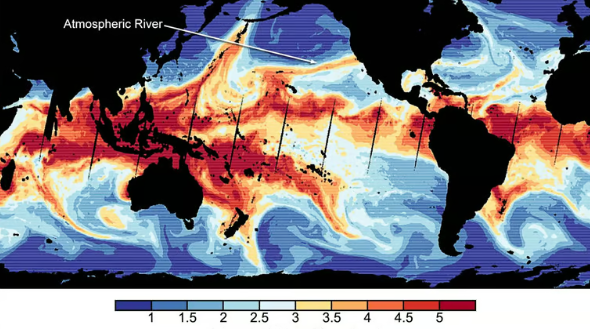Poleward Shift of Atmospheric Rivers (GS Paper 1, Geography)

Introduction
- Recent research has revealed a notable shift in the behavior of atmospheric rivers (ARs), with a movement of 6 to 10 degrees poleward over the last 40 years.
- This change has significant implications for global weather patterns, affecting water availability and climate stability.
- Understanding the mechanisms driving this shift and its consequences is crucial for effective water resource management and climate adaptation strategies.
Understanding Atmospheric Rivers
Definition and Importance
- Atmospheric rivers are concentrated bands of moisture in the atmosphere that transport vast amounts of water vapor from tropical regions to mid-latitude areas.
- These phenomena are essential for precipitation in many regions, providing over 50% of annual rainfall in places like California.
Key Characteristics
- Structure: Often likened to “rivers in the sky,” ARs can extend thousands of kilometers in length and vary widely in strength.
- Formation Conditions: They require strong low-level winds, high moisture levels, and orographic lift (the ascent of moist air over mountains) to produce precipitation.
- Categories: ARs are classified based on their intensity and duration, ranging from weak (Category 1) to exceptional (Category 5), with the latter causing significant impacts.
Drivers of the Poleward Shift
Changes in Sea Surface Temperatures:
- The cooling of sea surface temperatures in the eastern tropical Pacific, particularly since 2000, has been linked to La Niña conditions.
- This cooling alters moisture transport dynamics, leading to prolonged droughts in subtropical regions while increasing precipitation in higher latitudes.
Walker Circulation Dynamics:
- The strengthening of the Walker circulation during La Niña expands the tropical rainfall belt.
- This change, combined with shifts in atmospheric eddy patterns, creates high-pressure anomalies that redirect ARs towards the poles.
- The Walker circulation is a key component of the Earth's climate system, affecting weather patterns across the globe.
Long-Term Climate Trends:
- The Intergovernmental Panel on Climate Change (IPCC) has reported a global temperature rise of approximately 1.1°C since pre-industrial times.
- This warming has altered jet stream patterns, causing them to shift poleward, which in turn impacts the trajectories of ARs and increases the frequency of extreme weather events in the affected regions.
Implications of the Poleward Shift
Water Resource Management:
-
- Drought Risks: Regions like California and southern Brazil depend heavily on ARs for critical rainfall. A reduction in the frequency of ARs can lead to extended periods of drought, threatening agriculture and local communities that rely on consistent water supplies.
- Water Scarcity: As ARs become less frequent in these subtropical areas, water scarcity may escalate, resulting in increased competition for water resources among agricultural, industrial, and residential users.
Increased Flooding and Landslides:
-
- Extreme Rainfall: Areas at higher latitudes, such as the Pacific Northwest of the United States and parts of Europe, may experience more intense rainfall events, increasing the likelihood of flooding. These conditions can overwhelm local drainage systems and lead to property damage and loss of life.
- Landslide Risks: Regions with steep terrain may see an uptick in landslides and mudslides as heavy rainfall saturates the soil, particularly in deforested areas where vegetation typically helps stabilize the ground.
Impact on Arctic Climate:
-
- Sea Ice Melting: The influx of ARs into the Arctic region could further accelerate sea ice melting. Research indicates that atmospheric rivers have contributed significantly to the rise in summer moisture in the Arctic since 1979, posing threats to fragile ecosystems and coastal communities.
- Global Climate Feedbacks: Melting sea ice can exacerbate global warming by reducing the Earth's albedo effect (the reflection of sunlight), leading to further warming and ice loss.
Predictive Challenges:
-
- Natural Variability: The oscillation between El Niño and La Niña introduces significant variability in climate patterns, complicating predictions about the future behavior of atmospheric rivers. This variability may not be adequately captured by current climate models, leading to potential miscalculations in weather forecasts and water availability projections.
- Adaptation Strategies: To mitigate the risks associated with these uncertainties, it is crucial to enhance adaptive strategies for water resource management and disaster preparedness.
The Role of Climate Change
- Climate change is a driving force behind the observed poleward shift of atmospheric rivers.
- Warmer global temperatures increase the amount of moisture the atmosphere can hold, leading to more intense and damaging ARs.
- Studies have shown that atmospheric rivers in the Southern Hemisphere are shifting poleward by up to 0.72° per decade due to human-induced climate factors.
Conclusion
- The poleward shift of atmospheric rivers poses significant challenges to global weather patterns and water resource management.
- While higher latitudes may experience increased precipitation and flooding, lower latitudes are at risk of prolonged droughts.
- To effectively address these impacts, it is essential to invest in improved weather forecasting systems, enhance water infrastructure, and implement strategies to reduce greenhouse gas emissions.
- As we continue to navigate the complexities of climate change, understanding the dynamics of atmospheric rivers will be crucial for developing resilient strategies to safeguard our water resources and mitigate the effects of extreme weather events.
- The interconnected nature of these phenomena underscores the need for collaborative global efforts in climate adaptation and mitigation.


